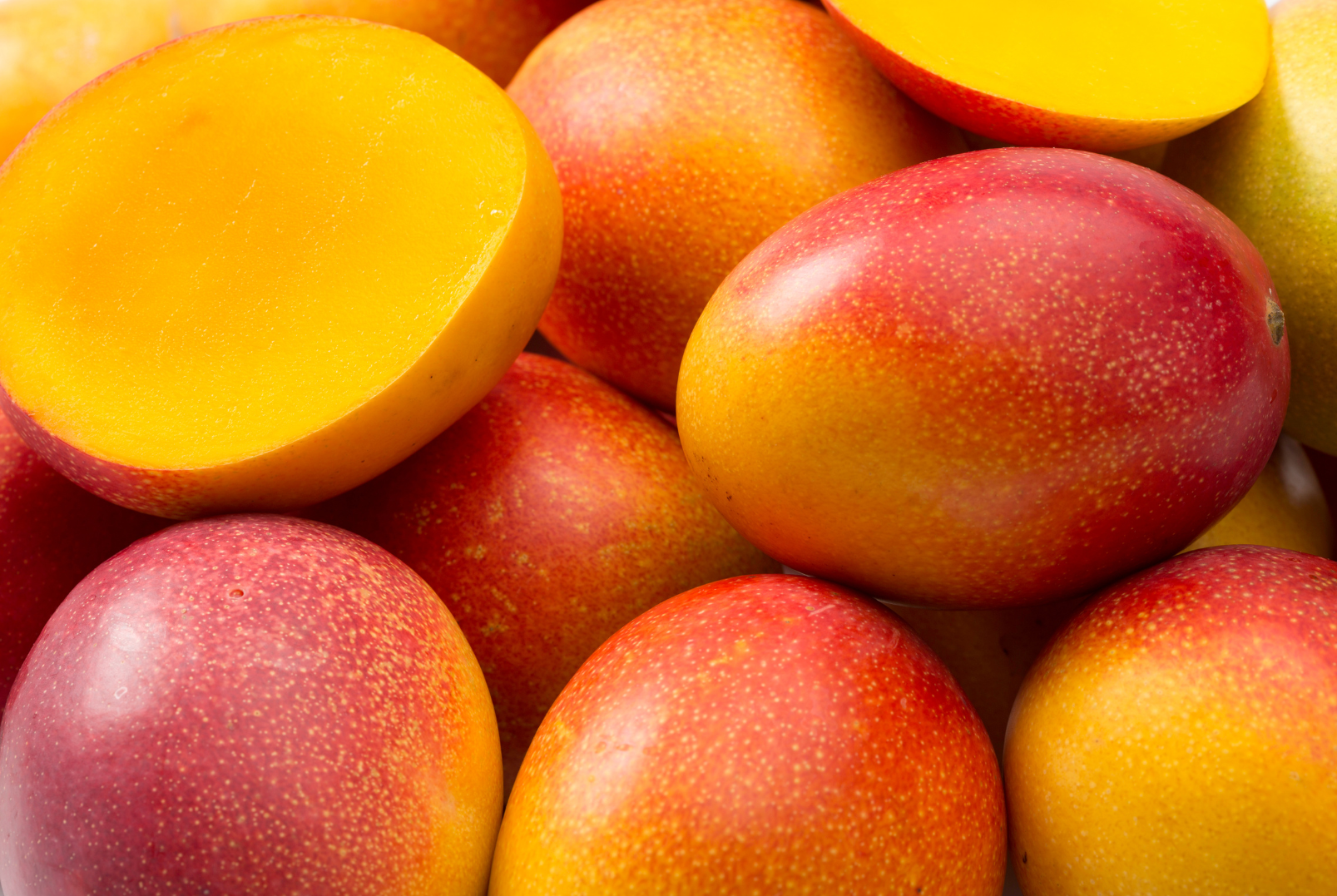Nährwert und gesundheitliche Vorzüge der Mango

Dieser Artikel ist auch in den folgenden Sprachen verfügbar
Dieser Artikel ist auch in den folgenden Sprachen verfügbar:
![]() English (Englisch)
English (Englisch) ![]() Español (Spanisch)
Español (Spanisch) ![]() Français (Französisch)
Français (Französisch) ![]() हिन्दी (Hindi)
हिन्दी (Hindi) ![]() العربية (Arabisch)
العربية (Arabisch) ![]() Ελληνικά (Griechisch)
Ελληνικά (Griechisch)
Viele halten die Mango für die „Königin“ der Früchte, denn sie wird frisch verzehrt und zur Herstellung von Desserts, Fruchtsäften und Marmeladen verwendet. Außerdem ist sie eine reiche Quelle für die Vitamine A, B und C, Zucker, Kohlenhydrate, Proteine, Fette, Ballaststoffe, Wasser und vieles mehr.
Im Einzelnen enthält 1 Frucht (336 g) laut US-amerikanischem Landwirtschaftsministerium (USDA):
- Energie: 202 kcal – 840 kJ
- Wasser: 281 g
- Eiweiß: 2,76 g
- Ballaststoffe, gesamt: 5.38 g
- Zucker, insgesamt, einschließlich NLEA: 46 g
- Kalium: 564 mg
- Kalzium: 37 mg
- Phosphor: 47 mg
- Magnesium: 33,6 mg
- Eisen: 0,538 mg
- Karotinoide: 61 mg
Mangos enthalten einige Spuren von Selen, Kupfer, Zink und Mangan. Was die Vitamine betrifft, so enthält sie 122 mg Vitamin C (mehr als 50 % der empfohlenen Tagesdosis), 181 μg Vitamin A und 3,02 mg Vitamin E.
Abgesehen davon, dass sie eine köstliche Frucht ist, sind mit ihrem Verzehr zahlreiche gesundheitliche Vorteile für den Menschen verbunden. Sie kann:
- das Risiko von (Dickdarm-, Brust-, Leukämie- und Prostatakrebs) verringern und das Immunsystem stärken dank der Antioxidantien (Beta-Carotin) und des hohen Gehalts an den Vitaminen C und A, die in der Mango enthalten sind.
- Senkung des Cholesterinspiegels dank des hohen Gehalts an Ballaststoffen und Vitamin C, die der Verzehr von Obst liefert.
- Verbessert die Gesundheit von Augen und Haut sowie die Verdauung
- Hilft, Anämie zu verhindern
- Fördert die Gesundheit des Herzens (Herz-Kreislauf-System) und senkt den Blutdruck
Trotz der vielen gesundheitlichen Vorteile sollten Mangos, wie jedes andere Lebensmittel auch, mit Bedacht verzehrt werden. Obwohl es nur sehr wenige Fälle von allergischen Reaktionen gibt, ist es am besten, die Frucht zu schälen und die Schale, die geringe Mengen von Uruisol enthält, nicht zu verzehren.
Mehr lesen
Nährwert und gesundheitliche Vorzüge der Mango
Mangobaum-Informationen und Sortenauswahl
Gewinnbringender kommerzieller Mango-Anbau – Mango-Produktion – Ein Überblick
Mango: Ertrag, Ernte und Nacherntebehandlung
Verweise
https://fdc.nal.usda.gov/fdc-app.html#/food-details/169910/nutrients
Find more information in the book: “Success in Agribusiness: Growing Mango successfully” written by James Mwangi Ndiritu
Codex Alimentarius Commission. General Principles of Food Hygiene CXC 1-1969. 2021.
De Graaf J. Developing a Systems Approach for Sternochetus mangiferae (Coleoptera: Curculionidae) in South Africa. J Econ Entomol. 2010; 103(5):1577–85.
Dias, C.S.; Rodrigues, R.G.; Ferreira, J.J. What’s new in the research on agricultural entrepreneurship? J. Rural. Stud. 2019, 65, 99–115.
FAO. The Future of Food Safety; FAO: Rome, Italy, 2019.
Grové T, De Beer MS, Daneel MS, Steyn WP. Scale and mealybug survey on mango in Mpumalanga and Limpopo Provinces South Africa. Acta Hortic. 2013; 1007:377–84.
Grové T, De Villiers EA, Daneel MS. Mango. In: Prinsloo GL, Uys VM, editors. Insects of cultivated plants and natural pastures in Southern Africa. Pretoria: Entomological Society of Southern Africa; 2015a. p. 574–88.
Grové T, De Villiers EA, Schoeman PS. Litchi. In: Prinsloo GL, Uys VM, editors. Insects of cultivated plants and natural pastures in Southern Africa. Pretoria: Entomological Society of Southern Africa; 2015b. p. 554–9.
Grové T, De Beer MS, Joubert PH. Monitoring fruit flies in mango orchards in South Africa and determining the time of fruit infestation. Acta Hortic. 2009; 820:589–96. .
Grové T, De Beer MS. Insect pests affecting the production of mango in South Africa. Acta Hortic. 2017b; 1183:297–304.
Grové T, De Beer MS. Species composition and abundance of fruit flies (Diptera: Tephritidae) in subtropical fruit orchards in the Mbombela Local Municipality South Africa. Fruits. 2019; 74(1):18–24
Haran J, Grové T, Van Noort S, Benoit L, Addison P. Natural biocontrol of fruit flies in indigenous hosts: A perspective for population control in the agroecosystem. Biol Control. 2019; 137:1–6.
Henri, D. C., Jones, O., Tsiattalos, A., Thebault, E., Seymour, C. L., van Veen, F. J. F. F., et al. (2015). Natural vegetation benefits synergistic control of the three main insect and pathogen pests of a fruit crop in southern Africa. J. Appl. Ecol. 52, 1092–1101.
Hill MP, Macfadyen S, Nash MA. Broad spectrum pesticide application alters natural enemy communities and may facilitate secondary pest outbreaks. PeerJ. 2017; 19(5):e4179.
Joubert PH, Daneel MS, Grové T. Progress towards Integrated Pest Management (IPM) on mangoes in South Africa. Acta Hortic. 2000;509:811–8.
Joubert E, Grové T, Booysen G. Evaluation of fruit fly (Diptera: Tephritidae) monitoring systems on mango in Limpopo Province South Africa. J Agric Sci Technol. 2015;B5:653–63.
Louw CE. The mango seed weevil, Sternochetus mangiferae (Fabricius) (Coleoptera: Curculionidae); understanding the pest in order to ensure effective control measures. Acta Hortic. 2013;992:441–57.
Louw E. Evaluation on the efficacy of different chemicals on gall fly larvae in mangoes. Subtrop Fruit J. 2021;30:18–20.
Kibira, M., Affognon, H., Njehia, B., Muriithi, B., Mohamed, S., and Ekesi, S. (2015). Economic evaluation of integrated management of fruit fly in mango production in Embu County, Kenya. Afric. J. Agric. Resour. Econ. 10, 343–353
King, T.; Cole, M.; Farber, J.M.; Eisenbrand, G.; Zabaras, D.; Fox, E.M.; Hill, J.P. Food safety for food security: Relationship between global megatrends and developments in food safety. Trends Food Sci. Technol. 2017, 68, 160–175.









































































